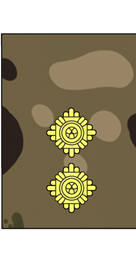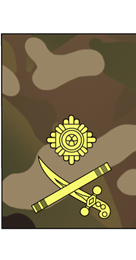Rank Lessons
Private/Marine
- On completion of Basic Training, all new soldiers start as Privates although the title may be Trooper, Gunner, Signaller, Sapper, Guardsman, Rifleman or even Kingsman depending on the Corps or Regiment in which they are serving.

Lance Corporal
- Promotion to Lance Corporal may follow after Initial Trade Training, or after about 4 years as a Private.
- Lance Corporals are required to supervise a small team of up to four soldiers called a section.
- They also have opportunities to specialise and undertake specialist military training.

Corporal
- After 6 to 8 years, and depending on ability to lead, promotion to Corporal typically follows.
- In this rank, additional trade and instructor qualifications can be gained.
- Corporals are given command of more soldiers and equipment – such as tanks and guns.

Sergeant
- Sergeant is a senior role of responsibility, promotion to which typically takes place after 12 years of service, depending on ability.
- Sergeants typically are second in command of a troop or platoon of up to 35 soldiers, with the important responsibility for advising and assisting junior officers.

Staff/Color Sergeant
- After a few years as a Sergeant promotion to either Staff or Colour Sergeant may follow.
- This is a senior role combining man and resource management of around 120 soldiers, or even command of a platoon or troop.

Warrant Officer Class 2
- This is a senior management role focussing on the training, welfare and discipline of a company, squadron or battery of up to 120 soldiers.
- WO2s act as the senior advisors to the Major in command of the sub-unit and may also be selected for a commission as an Officer.

Warrant Officer Class 1
- The most senior soldier rank in the British Army, typically reached after 18 years of outstanding service. WO1 are the senior advisors of their unit’s Commanding Officer, with leadership, discipline and welfare responsibilities of up to 650 officers and soldiers and equipment.

Second Lieutenant
- This is the rank held on commissioning from the Royal Military Academy Sandhurst.
- It is normally held for 1 to 2 years.
- During their time as a Second Lieutenant, Officers complete special to arms training relevant to their Corps.
- After training is complete, they are responsible for leading up to 30 soldiers in a platoon or troop, both in training and on operations.

Lieutenant
- The rank of Lieutenant is typically held for 2 to 3 years.
- They normally command a platoon or troop of around 30 soldiers, with increased responsibilities from being a Second Lieutenant.
- They also have the opportunity to gain specialised skills outside their unit.

Captain
- The rank of Captain is typically held for 5 – 10 years.
- Captains are normally made second-in-command of a sub-unit of up to 120 soldiers.
- They are key players in the planning and decision-making process, with tactical responsibility for operations on the ground as well as equipment maintenance, logistic support and personnel.

Major
- Typically a Major will be given command of a sub-unit of up to 120 officers and soldiers with responsibility for their training, welfare and administration both in camp and op operations, as well as the management of their equipment.

Lieutenant Colonel
- Lieutenant Colonels typically command units of up to 650 soldiers, containing four or five sub-units – known as the Commanding Officer.
- They are responsible for the overall operational effectiveness of their unit in terms of military capability, welfare and general discipline.
- Commanding Officer is typically a two-year appointment.

Colonel
- Colonels are not usually field commanders (except in the Royal Army Medical Corps).
- Typically they serve as staff officers between field commands at battalion/brigade level.
- It is the lowest of the staff ranks and they are the principal advisors to senior officers.

Brigadier (aka 1 star)
- Brigadier is not considered to be a General officer rank by the British Army but rather a Field officer rank.
- Brigadiers can command a brigade or be a director of operational capability groups such as a director of staff.

Major General (aka 2 star)
- Major Generals command formations of division size and the Royal Military Academy Sandhurst, and hold senior staff appointments in the Ministry of Defence and other headquarters.

Lieutenant General (aka 3 star)
- Lieutenant Generals command formations of Corps size and other commands in the UK and overseas.
- They also hold very senior staff appointments in the Ministry of Defence and other headquarters.

General (aka 4 star)
- Generals hold the most senior appointments – such as Chief of Defence Staff, Vice Chief of Defence Staff, Chief of the general Staff, Deputy Supreme Allied Commander Europe, and Commander in Chief Land Forces.

Field Marshal
- The highest rank in the British Army since 1736.
- The rank of Field Marshal has become an honorary rank, the last active officer to be promoted to the rank was in 1994.
